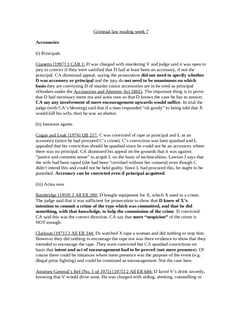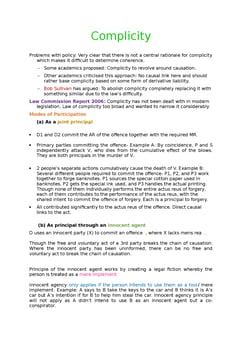DPP v Smith [2006] Crim LR 528
Judgement for the case DPP v Smith
KEY POINTS
The Defendant was alleged to have forcibly cut off the Victim's ponytail without obtaining her consent. This act raised concerns regarding the potential harm inflicted upon the Victim, prompting a closer examination of whether the cutting off of the victim's hair could be classified as constituting actual bodily harm.
The legal framework being applied in this context was Section 47 of the Offences against the Person Act 1861 (24 & 25 Vict. c.100). This statutory provision was relevant to the assessment of whether the actions of the defendant fall within the scope of offenses involving harm to the person.
The examination of the specific language and intent outlined in Section 47 will play a crucial role in determining the legal implications and potential consequences for the Defendant regarding the alleged act of cutting off the Victim's hair without her consent.
FACTS
The Michael Ross Smith (‘Defendant’) faced charges of assault occasioning actual bodily harm, as stipulated by Section 47 of the Offences against the Person Act 1861. The Michelle Tether (‘Victim’), identified as the Defendant's ex-partner, visited his home, where he allegedly used kitchen scissors to cut off the ponytail at the back of her head without her consent.
During the trial, a submission of no case to answer was made at the close of the prosecution's case. The argument presented was centered on the contention that the prosecution failed to establish the critical ingredient of the offense, namely actual bodily harm.
The prosecution asserted that cutting someone's hair without consent constituted assault, naturally resulting in actual bodily harm, and emphasized that permanency of harm was unnecessary for the Section 47 offense.
However, the court found that the prosecution did not prove actual bodily harm, as there was an absence of bruising, bleeding, or cutting of the skin.
No expert evidence was presented regarding psychological or psychiatric harm, leading the court to conclude that even though the Victim experienced distress, it alone could not amount to actual bodily harm.
The court determined that a crucial element of the offense was missing, resulting in a decision that there was no case to answer.
The prosecution appealed the decision through a case stated. During the appeal, the Defendant's counsel focused on medical and scientific evidence, arguing that, according to such evidence, the hair shaft, as opposed to the root, was deemed no more than dead tissue.
This line of argument aimed to establish that the actions in the present case did not meet the threshold for actual bodily harm.
JUDGEMENT
The appeal was allowed, and it was held that, from a medical and scientific perspective, even if the hair above the scalp's surface was considered nothing more than dead tissue, it was an integral part of the body and remained attached to it.
The court emphasized that hair was intrinsic to each individual and contributed to their identity. As long as it was attached to the body, it fell within the definition of '‘bodily’ in the context of ‘‘actual bodily harm,’’ as the term pertained to the body of the individual victim.
The court concluded that cutting off a substantial part of the victim’s hair during an assault, like applying paint or a damaging substance that marked or harmed the hair without causing injury elsewhere, had the potential to constitute an assault leading to actual bodily harm.
The trial court was deemed to have erred in law, as this understanding clarified that harm to the hair, which was an intrinsic part of the Victim's body, could qualify as actual bodily harm. The appeal was allowed based on this interpretation.
COMMENTARY
The prosecution argued that cutting hair without consent amounted to assault and resulted in bodily harm, emphasizing that permanency wasn't necessary.
The trial court ruled in favor of the Defendant, citing the lack of physical evidence and expert testimony regarding actual bodily harm. The victim's distress alone was deemed insufficient.
On appeal, the Defendant's counsel highlighted medical evidence, asserting that the hair shaft, though dead tissue, was integral to the body.
The appeal succeeded, establishing that harm to the victim's hair, intrinsic to identity, could qualify as actual bodily harm.
ORIGINAL ANALYSIS
Defendant cut off Victim’s ponytail but was acquitted of actual bodily harm since there was no “bruising, bleeding or cutting of the skin”.
However CA said that, whatever the biology, hair was still a part of the body and that cutting it off, therefore, was actual bodily harm.
Sir Igor Judge P
Stated that Chan-Fook established that it was not merely physical injuries, but mental ones too that were to be considered.
Therefore the traditional limitation to cuts, bruises and bleeding was no longer in effect. Cutting hair off is not trivial or insignificant.
RELATED CASES
For Further Study on DPP v Smith

Criminal Law notes fully updated for recent exams at Oxford and Cambrid...
Need instant answers? Our AI exam tutor is here to help.
Ask questions 🙋 Get answers 📔 It's simple 👁️👄👁️
Our AI is educated by the highest scoring students across all subjects and schools. Join hundreds of your peers today.
Get StartedRelated Product Samples
These product samples contain the same concepts we cover in this case.
| Criminal Law | Homicide Notes (20 pages) |
| Criminal Law | Non Fatal Offences Against The Person Notes (17 pages) |
| Criminal law | Offences Against The Person Notes Real Notes (28 pages) |

 Since 2010, Oxbridge Notes has been a trusted education marketplace, supplying high-quality materials from top achievers at universities like Oxford, Cambridge, LSE, Harvard, and Yale.
Since 2010, Oxbridge Notes has been a trusted education marketplace, supplying high-quality materials from top achievers at universities like Oxford, Cambridge, LSE, Harvard, and Yale.